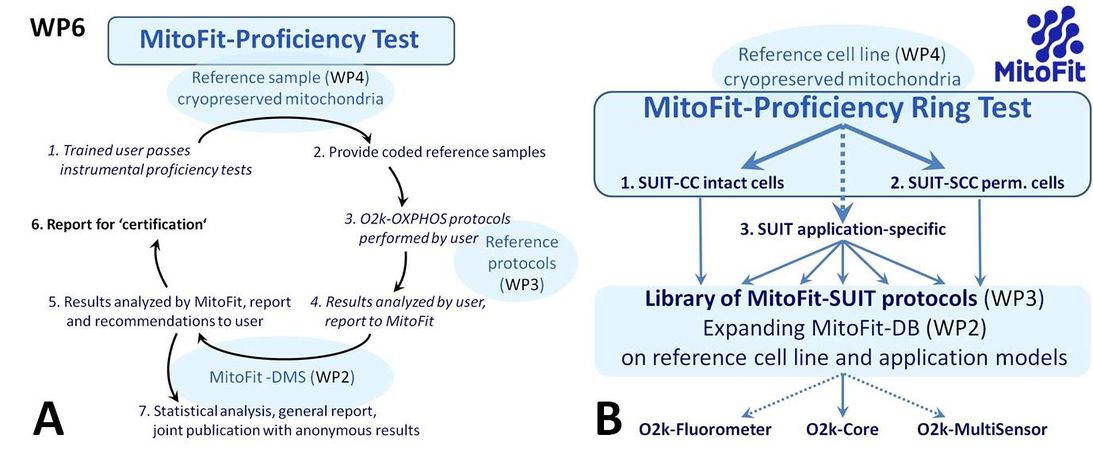Difference between revisions of "Development MitoFit proficiency test"
| Line 14: | Line 14: | ||
== Abstract == | == Abstract == | ||
:::: A [[proficiency test]] is an essential part of | :::: A [[proficiency test]] is an essential part of quality control designed to minimize experimental error in diagnostic tests. Instrumental errors can be detected by routine calibration and instrumental performance tests (instrumental background) and avoided by technical service before conducting a diagnostic test, should instrumental validation indicate a problem in advance of an experiment (WP3). In addition, reference samples with properties relevant for the diagnostic assay (WP4) are analysed at different time points during the longitudinal progress of a project or in the direct context of patient diagnostic assays, such that quantitative results are validated. The purpose of the proficiency test is also to help improve performance and to determine if the test methods in use are reliable and reproducible (Figure 6A). Interlaboratory ring testing of reference samples is known as an external quality control (Figure 6B). The need for such a proficiency testing scheme for respiratory OXPHOS analysis is frequently discussed in the literature, but no generally applicable solution is available yet. An interlaboratory comparison revealed disturbingly high variability of results with spectrophotometric (enzymatic) analysis of respiratory complex activities (Gellerich et al 2004). In contrast to respiratory OXPHOS analysis, enzyme kinetic OXPHOS assays are routinely performed on frozen samples. The interlaboratory MitoFit-PT will be developed and introduced in practice as a world-wide innovation in the field of mitochondrial respiratory physiology. A proficiency ring test is obligatory for certified laboratories. | ||
<gallery mode=packed widths="1000px" heights="300px">File:MitoFit proficiency test.jpg| Development of the MitoFit proficiency test (MitoFit-PT). '''A:''' Intra-laboratory proficiency test from training (1), assaying reference samples (2-4), to controlling and reporting by the MitoFit core team (5-7). '''B:''' Extension to the interlaboratory MitoFit proficiency ring test: Reference SUIT protocols on coupling control (CC with intact cells) and sequential substrate-coupling control (SCC with permeabilized cells) are applied in the ring test including laboratories of the international strategic partners, providing a prototype test scenario and expanding the range of application-specific SUIT protocols in the MitoFit-data base. O2k-Core applications are extended by applications of the O2k-Fluorometer and other O2k-MultiSensor modules.</gallery> | <gallery mode=packed widths="1000px" heights="300px">File:MitoFit proficiency test.jpg| Development of the MitoFit proficiency test (MitoFit-PT). '''A:''' Intra-laboratory proficiency test from training (1), assaying reference samples (2-4), to controlling and reporting by the MitoFit core team (5-7). '''B:''' Extension to the interlaboratory MitoFit proficiency ring test: Reference SUIT protocols on coupling control (CC with intact cells) and sequential substrate-coupling control (SCC with permeabilized cells) are applied in the ring test including laboratories of the international strategic partners, providing a prototype test scenario and expanding the range of application-specific SUIT protocols in the MitoFit-data base. O2k-Core applications are extended by applications of the O2k-Fluorometer and other O2k-MultiSensor modules.</gallery> | ||
Revision as of 02:56, 1 April 2022
Template:MitoFit highlights page name
- The project MitoFit highlights the benefits of mitochondrial fitness.
WP6
- Development of the MitoFit proficiency test
Abstract
- A proficiency test is an essential part of quality control designed to minimize experimental error in diagnostic tests. Instrumental errors can be detected by routine calibration and instrumental performance tests (instrumental background) and avoided by technical service before conducting a diagnostic test, should instrumental validation indicate a problem in advance of an experiment (WP3). In addition, reference samples with properties relevant for the diagnostic assay (WP4) are analysed at different time points during the longitudinal progress of a project or in the direct context of patient diagnostic assays, such that quantitative results are validated. The purpose of the proficiency test is also to help improve performance and to determine if the test methods in use are reliable and reproducible (Figure 6A). Interlaboratory ring testing of reference samples is known as an external quality control (Figure 6B). The need for such a proficiency testing scheme for respiratory OXPHOS analysis is frequently discussed in the literature, but no generally applicable solution is available yet. An interlaboratory comparison revealed disturbingly high variability of results with spectrophotometric (enzymatic) analysis of respiratory complex activities (Gellerich et al 2004). In contrast to respiratory OXPHOS analysis, enzyme kinetic OXPHOS assays are routinely performed on frozen samples. The interlaboratory MitoFit-PT will be developed and introduced in practice as a world-wide innovation in the field of mitochondrial respiratory physiology. A proficiency ring test is obligatory for certified laboratories.
Development of the MitoFit proficiency test (MitoFit-PT). A: Intra-laboratory proficiency test from training (1), assaying reference samples (2-4), to controlling and reporting by the MitoFit core team (5-7). B: Extension to the interlaboratory MitoFit proficiency ring test: Reference SUIT protocols on coupling control (CC with intact cells) and sequential substrate-coupling control (SCC with permeabilized cells) are applied in the ring test including laboratories of the international strategic partners, providing a prototype test scenario and expanding the range of application-specific SUIT protocols in the MitoFit-data base. O2k-Core applications are extended by applications of the O2k-Fluorometer and other O2k-MultiSensor modules.
Progress and next steps

